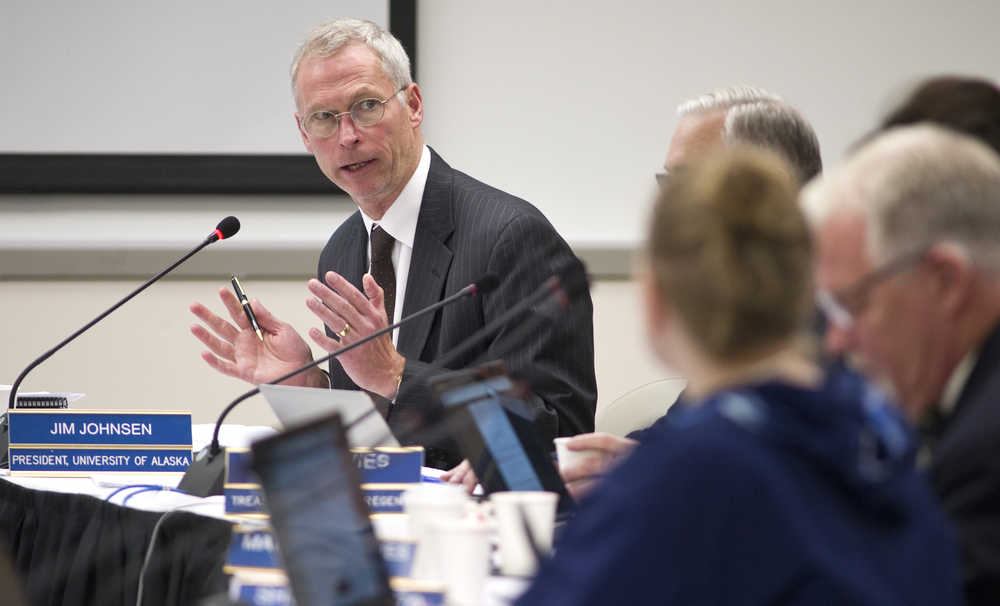Student tuition at University of Alaska may increase by 10 percent next year under an operating budget outlined by President Jim Johnsen at Thursday’s Board of Regents meeting in Juneau.
For Fiscal Year 2018, Johnsen laid out a $345 million state budget — a $20 million increase over this year’s state operating budget — which assumes getting $335 from the state Legislature and the other $10 million coming from the tuition increase.
“I think students are well aware of our position vis-à-vis other states and the tough fiscal times we’re in. They understand the value of the education,” Johnsen said during a presentation to the board at the University of Alaska Southeast’s Student Recreation Center.
Tuition has been rising over the past several years. Still, Johnsen said tuition at UA is 16 percent under the Western state’s average.
“We recently identified as the single most affordable higher education system in the country. I think there’s an opportunity to move that. We’ll be coming back in November with the actual request,” Johnsen said.
He said he’ll be collaborating with student governments to work through a tuition increase in the fall.
“I really value their perspectives and I want very much to be working with them as we work on this particular assumption and priority,” Johnsen said.
[See Johnsen’s budget presentation here]
He said he doesn’t anticipate more learning centers closing next year (UA closed the Galena and McGrath Learning Centers this year and will be closing the Shishmaref Learning Center), but he said there will be a focus on bringing costs down at some community campuses.
“I’ve taken a strong position of protecting, supporting those community campuses and providing access to people in rural Alaska,” Johnsen said. “At the same time our costs in many of those community campuses are just not sustainable, so how can we both maintain presence there and bring cost structures down? And that’s the conversation we’re having.”
The $345 state budget also includes $17 million in strategic investments. They include deferred maintenance; student recruitment, retention and completion; research; K through 12 partnerships; workforce development and economic diversification.
During his budget presentation, Johnsen previewed a new financial model, which he said provides a clear and balanced path to sustainability. One of its goals is to achieve a state workforce of 65 percent by 2025. That means having 65 percent of Alaska’s workforce be made up of jobs requiring post-secondary education. Currently, only 37 percent of the state’s jobs require that. To reach the goal, Johnsen said the model requires increases in recruitment, retention and completion rates as well as increases to enrollment.
As the state’s general fund appropriation moves down over the years, Johnsen’s financial model has tuition moving up over time. Those figures will be benchmarked to national tuition averages plus the Alaska cost of living differential.
“You develop targets out there and then build annual budgets, annual enrollment plans, annual academic plans to hit those numbers by 2025,” he said. “This becomes very powerful in terms of building partnership and coalitions with employers, with students, with chambers, with legislators because they see exactly where we’re heading and the compact that we are willing to make with our state to provide cost effective, high quality and accessible education.
Regent Mary Hughes said Johnsen’s budget presentation was the best she’s heard in 15 years. She congratulated him and his team for moving the university into a positive future.
“We are really working on having excellence at the University of Alaska and that doesn’t necessarily mean we have to have more money. It’s a way of teaching Alaskans and making sure we’re there for all Alaskans,” she said. “Not everyone agrees with everything, but we have to make decisions, and this gives us a wonderful foundation from which to make those.”
Regent John Davies agreed that it was a great presentation, but he said it wasn’t “sufficient.”
“What’s missing in here is a strategic focus on … creativity. I chafe at a whole focus at a university that’s just about workforce development. It’s very important, but it’s not sufficient,” he said. “I would like to see in our strategic investment a bullet that talks about citizenship or something else that reflects the importance of life beyond just work.”
The University of Alaska this year is currently operating on a state budget of $325 million — a difference of more than $50 million from what the Board of Regents had originally requested.
Johnsen said the campuses “did a lot of heavy lifting” to make up the gap. The university eliminated more than 500 positions, reduced the assignments or increased the workload of more than 250 positions and reduced academic programs with fewer sections and larger class sizes.
The UA Board of Regents won’t be approving next year’s budget until November.
• Contact reporter Lisa Phu at 523-2246 or lisa.phu@juneauempire.com.
Read more local news:
Volunteers still needed for live disaster drill Saturday at Juneau aiport
Indictments: Alleged home intruder told Juneau police he was just at wrong house
Human remains found at Dredge Lake, believed to be man reported missing six years ago

